From the groundbreaking
series "Art Answers the
Questions of Your Life"
SARGENT'S
MADAME X;
OR, ASSERTION AND RETREAT IN
WOMAN
by Lynette Abel
I have loved
this portrait of Madame Pierre Gautreau by the
American painter, John Singer Sargent, titled
Madame X, since the first time I saw
it.
Through my study
of Aesthetic Realism, I'm grateful
to be learning that what makes a work of art
beautiful is what we are hoping for in our
lives. "All beauty,"
Eli Siegel stated, "is a making one of
opposites; and the making one of opposites
is what we are going after in ourselves."
I've come to see that Sargent's dramatic
portrait makes a one of opposites I was
longing to make sense of in myself.
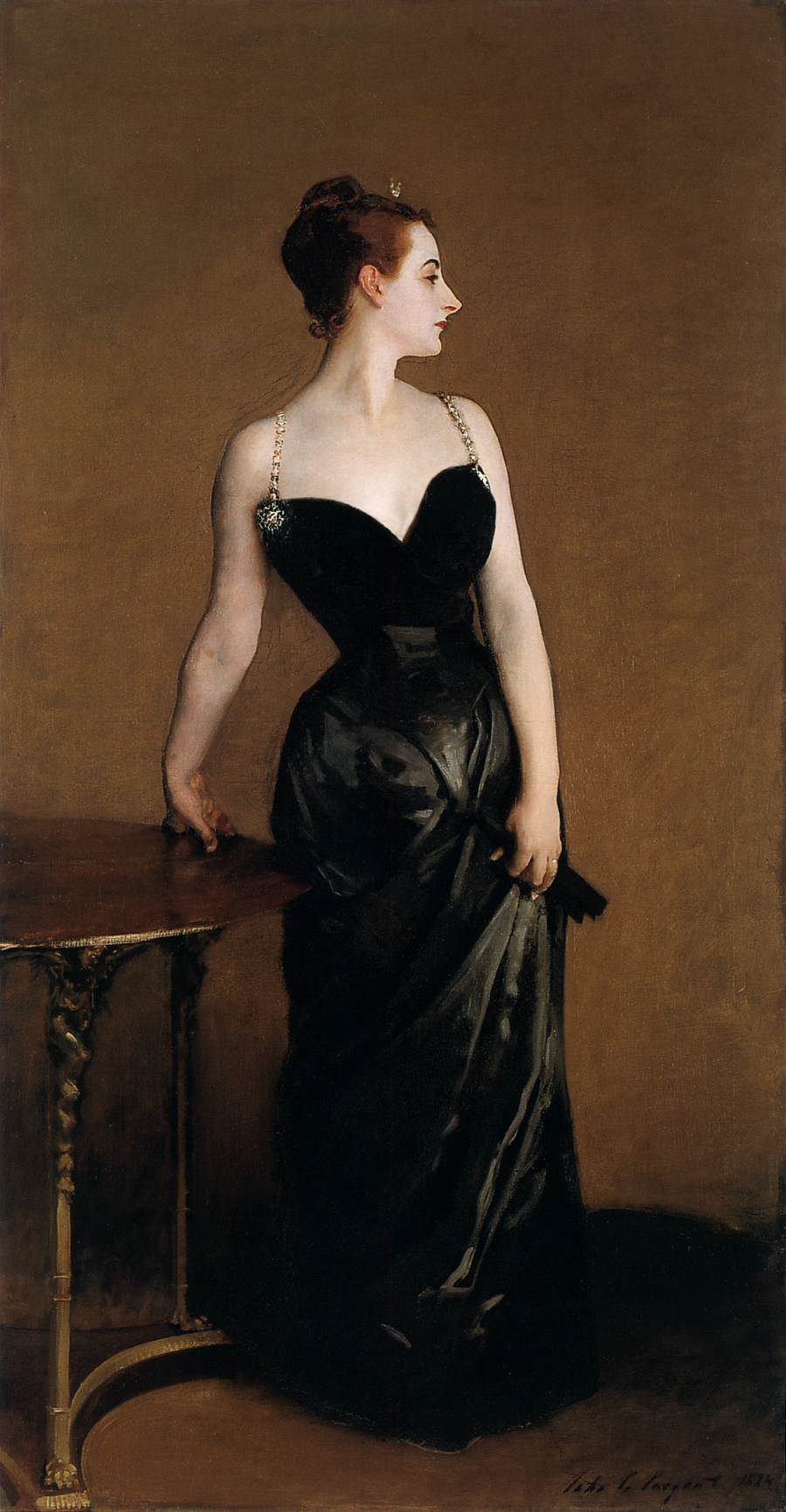
John Singer Sargent, Madame X, 1883-84.
Oil on canvas, 82 1/8 x 43 1/4 in.
Metropolitan Museum of Art, NY
In his surprising, remarkable essay,
"A
Woman Is the Oneness of Aesthetic
Opposites," Mr. Siegel
describes 15 pairs of universal qualities in
women, including:
"8. Advancing:
Recessive. Towards something
is in the feminine mind importantly: the
future as outward and to be visited and
had. But how much retreat is in woman,
too, the unseen sinking, the leaving for a
previously chosen background.
I
think Sargent's Madame X is an
opportunity to study these opposites, which
all women have and men have them too.
Sargent shows a haughty
woman, ostentatious in her black satin dress
with its jeweled straps--it reveals
and hides
at once. This portrait, when it first
appeared at the Paris Salon in l884, shocked
people and caused such a scandal that
Sargent had to withdraw it. Yet, if
all this painting showed was ostentation, I
believe Sargent wouldn't have said when he
sold it to the Metropolitan Museum in l9l6,
"I suppose it is the best thing I have
done." It was at this time that
Sargent asked that the title of the painting
be changed to Madame X. The
name Madame X is both more assertive in its
dramatic quality and also more mysterious,
and accenting the impersonal, it makes this
portrait seem to stand for the idea of woman
as such.
I had
the great honor to study in classes with Eli
Siegel. And as I heard kind, critical, and
comprehending questions, I felt understood,
something I never imagined I would feel. In an
Aesthetic Realism class, Eli Siegel asked
me: "Do you believe you have a fight
between showing off and retreating?"I was
surprised, but said without hesitation, "Yes."
It was true. He continued: "You don't
know whether to show off or to go into
yourself.? Are there two different motions in
you at the same time--ostentation and
retreat?" There definitely were. For
instance, I wanted a man to think I was the
most charming woman he had ever known--that as
I walked into a room I would be the center of
interest. And at the same time I also
wanted to retreat, be aloof--if I did have to
talk to a man, my mind would go blank--I often
couldn't think of anything to say.
Having this purpose, which I learned was
contempt--wanting to have a big effect while
at the same time retreating and hiding from
the world around me--made for great discomfort
and pain. I think in this portrait
Sargent shows powerfully that the opposites of
assertion and retreat can be beautifully
one. The artist's purpose is to respect
the world through wanting to see it as it
truly is, and this is the only purpose which
will enable a woman to put these opposites
together beautifully in herself.
As I
was writing this paper, I learned that Mr.
Siegel had spoken of John Singer Sargent in an
Aesthetic Realism lesson given to a young
woman. He asked her, "Do you believe
that a self is a oneness of the greatest
outwardness and the greatest
inwardness?" And he explained:
"There are two qualities. Take the
ladies of John Singer Sargent--they're very
demure, the ladies of 1905, and then also they
express themselves.
There
are Mrs. Frederick Guest;
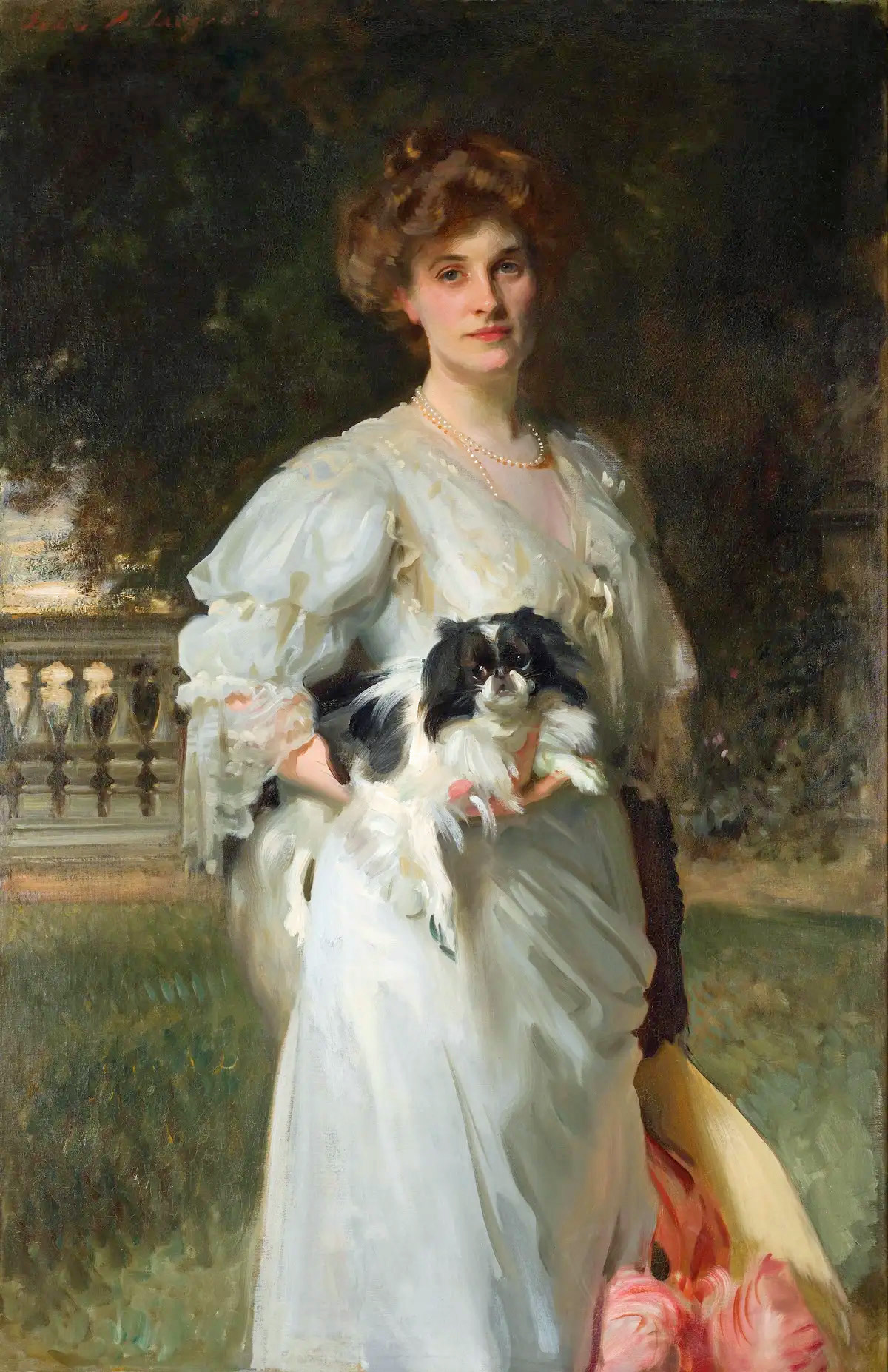
Lady Agnew;

Mrs. Louis Raphael;

and
there is Madame X.

Opposites
in a Portrait & in Life
One of the first things that struck me about Madame
X was the stark contrast between black
and white. There is assertion and
showiness in the expanse of very white skin,
from her high forehead down her graceful neck,
shoulders, and arms. At the same time,
though the black of her dress is bold, it is
also receding, deep, mysterious. She is
surrounded too by brown, which while accenting
the muted, is not just recessive--its
rich color has both glow and
shadow.
 Madame Gautreau was one of Paris's notorious
beauties. She wore lavender powder and
prided herself exceedingly on her
appearance. In the book The
Metropolitan Museum of Art Favorite
Paintings, I was affected to read this
commentary on her by A. Hyatt Mayer:
Madame Gautreau was one of Paris's notorious
beauties. She wore lavender powder and
prided herself exceedingly on her
appearance. In the book The
Metropolitan Museum of Art Favorite
Paintings, I was affected to read this
commentary on her by A. Hyatt Mayer:
Her
studied, indifferent, statuesque presence
stopped parties, stopped traffic in the
street....But one day on the beach at Cannes,
Madame Gautreau overheard a woman say that she
was beginning to look worn. She drove in
a closed carriage to her hotel, took a
darkened compartment on the train to Paris,
and shut herself up for the rest of her life
in dim rooms without mirrors.
I
think Madame Gautreau would have felt
comprehended, as I did, by questions Eli
Siegel asked me, including: "Do you think
[there can be] an accuracy in going forward
and retreating--of being ourselves from
within and also showing ourselves?
There has been great discomfort because
people have wanted to retreat....Do you
think everything can be done with a oneness
of advance and retreat?" "Yes," I said. And
Mr. Siegel asked me: "Can you show off
discreetly? Try to show off
gracefully." I have been asking as I
looked at this painting, "What does it means
to show off gracefully?" And I have seen
what Aesthetic Realism teaches--that if a
woman's conscious purpose is to know and
like the world and have other persons like
it, she will assert herself in a way that is
graceful. And I am so glad to be
learning more about this in my happy
marriage to writer and Aesthetic Realism
Associate, Michael
Palmer.
An
important element central to the beauty of
this painting is the way Sargent posed his
subject, which I learned was not come to
easily. In his biography John Singer
Sargent: His Portrait, Stanley Olson
writes:
He
sketched her seated in a contorted pose.
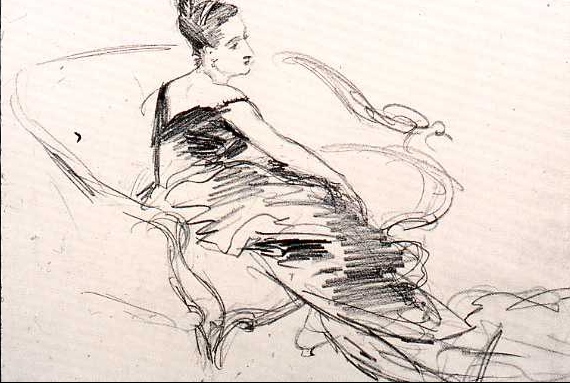
He
sketched her with her head raised, then
lowered looking at a book,

then
playing the piano. He did...her
seated in a different posture,

and
a brisk oil study of her holding out a
champagne glass at a table.
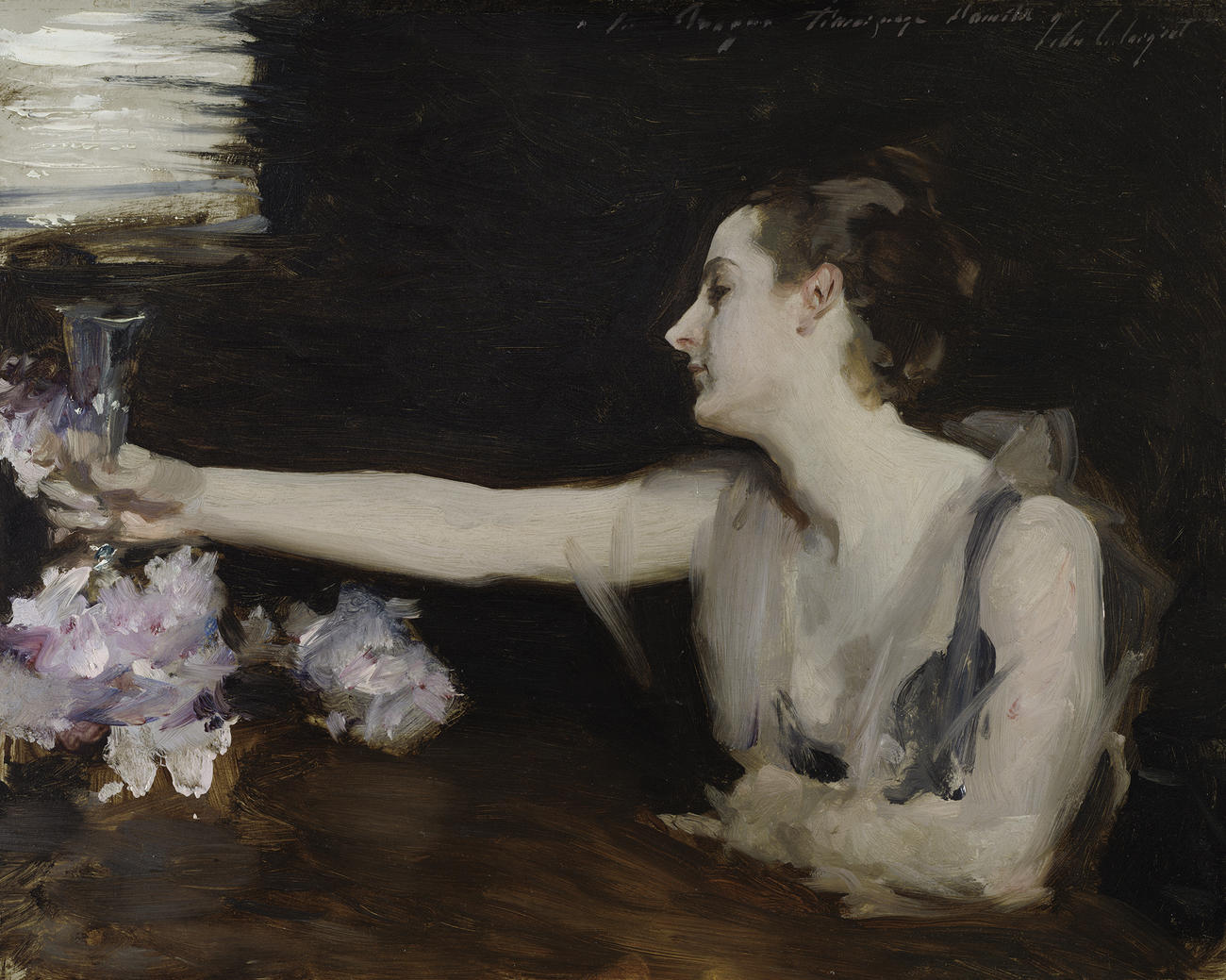
In desperation he drew her back
as she kneeled on a sofa looking out of
the window.
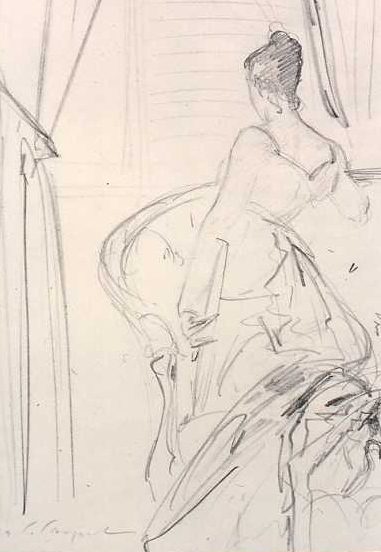
Finally he asked her to stand
beside an Empire table, twisted into a
conscious profile."

Sargent chose this pose for Madame Gautreau
carefully: her body boldly facing forward
while her head is turned in profile. A
profile by its very nature is both assertion
and retreat--half of one's face is hidden
while at the same time the part that shows
can seem more defined than full face.
Surprisingly, in placing her head in
profile, Sargent has technically put
together the very opposites that have
troubled many women--including the subject
for this painting, and myself. Mr.
Siegel pointed out in a class once, "The
profile of a person is the more intellectual
part because the angle seems to stand more
for thought." So, in this painting,
flesh and thought are together.
One of the
reasons I am so affected by Madame X is that
Sargent was trying to present this woman with
entirety --there is a mingling of admiration,
criticism and comprehension. One notices
a very pink ear, as if she is listening--and
listening is yielding. Was there
something she was burning to hear? I was
affected to see that the means by which
reality enables us to take in the world,
Sargent has highlighted in this lady with the
warm colors of pink and red: her eye, nose,
mouth and hands. And I was thrilled to see
what my colleague, Dorothy
Koppelman, pointed
out to me--that even the most abstract thing
in this painting--space--puts together
assertion and retreat. The space between
the arm that leans on the table and her dress
has the same form as the most prominent thing
in this painting--her nose: it goes out and
in.
We
feel the assertion in this woman. Her
left side is a sharply delineated outline from
the top of her head down her nose and chin and
all the way down her arm. Yet, her other
arm recedes as she leans back, with the
modelling of soft shadowy contours down her
arm. This arm is at once forward and
back, showy and retreating in its gentle
turning motion. She is depending on the
table but she is also assertively grasping it.
Sargent shows that Madame Gautreau, in her
haughtiness, needs that table. I learned
from Aesthetic Realism a woman needs the world
to express and show herself truly. from
the top of her head down her nose and chin and
all the way down her arm. Yet, her other
arm recedes as she leans back, with the
modelling of soft shadowy contours down her
arm. This arm is at once forward and
back, showy and retreating in its gentle
turning motion. She is depending on the
table but she is also assertively grasping it.
Sargent shows that Madame Gautreau, in her
haughtiness, needs that table. I learned
from Aesthetic Realism a woman needs the world
to express and show herself truly.
The table
too, advances and retreats. And look at
the gentle assertion and retreat in the way
the curve at the base of the table is
continued in reverse by the hem of her dress.
Sargent also uses color to continue this
relation of woman and table. Her
reddish, brown hair is mahogony, like the
table; the bright highlight on its edge is
like the bright ornament in her hair.
And the twist of the table leg in the
foreground is like the gentle twisting of her
arm.
 This
arm is continued by the vertical line of the
table leg in the background, appearing almost
as an extension of that arm; something sinuous
and bright is supported by something straight
in the shadows.
This
arm is continued by the vertical line of the
table leg in the background, appearing almost
as an extension of that arm; something sinuous
and bright is supported by something straight
in the shadows.
How
different this portrait would be were that
table absent. We see her with more
power, more depth of meaning because of
it. One of the things I see from this
is that in order to show oneself gracefully,
you have to be proud of your need for
something else--the world. I thank Eli
Siegel and Aesthetic Realism for enabling me
to feel this pride so richly and deeply.
Resources about John Singer
Sargent
See Metropolitan
Museum
of Art, New York, for the original
portrait: "Madame X" of 1884.
See Terrain
Gallery, where you will find Eli
Siegel's historic 15 questions, Is
Beauty
the Making One of Opposites?
Boston
Museum
of Fine Arts: Online are many wonderful
pages of thumbnail reproductions not
only of oil paintings but watercolors and
drawings, and very many sketches on paper.
"John
Singer
Sargent: Outside the Frame," a MacArthur
Foundation sponsored video on DVD,
narrated by Jacqueline Bisset. (Library
Media Project, Chicago, IL) Described this
way: "Shows the art very well, with full
views and details. Good use of period
photographs and location shots." (Also
available
on Amazon.com.)
*I
respect
Stanley Olsen's book John Singer
Sargent: His Portrait and
recommend it. His description of how Madame
Gautrau came to have just the pose we see in
the masterpiece "Madame X" gives a clear and
vivid picture.
Also
see Strapless: Madame X and the
Scandal That Shocked Bell Epoque Paris
by Deborah Davis. This link is to Barnes
& Noble and has reader reviews. Library
Journal says this: "With its
intriguing set of circumstances, lively
writing, and an eye for detail and nuance,
the book offers art history, social
commentary, and gossip." I question the
reliability of the "gossip" (which declines
into innuendo). The book has useful
background information which should be read,
however, with a critical eye.
ArtCyclopedia:
Sargent's
Paintings in Museums and Galleries.
Comprehensive collection of links in the
United States.
Other
Aesthetic Realism Resources
Sargent's
Madame X
on YouTube
The
Aesthetic
Realism Teaching Method
The
Aesthetic
Realism Theatre Company
Eli
Siegel,
founder of Aesthetic Realism: A Biography
Friends
of
Aesthetic Realism—Countering the
Lies
Photography
Education:
the Aesthetic Realism Viewpoint
The
Terrain Gallery / Aesthetic Realism
Foundation
Aesthetic
Realism:
A New Perspective for Anthropology &
Sociology
Alice
Bernstein,
Aesthetic Realism Associate
Ellen
Reiss,
Aesthetic Realism Chair of Education, on
poet Robert Burns
About
Eli
Siegel
Eli
Siegel's
'Is Beauty the Making One of Opposites?'
Donita
Ellison, Art Educator, Aesthetic Realism
Associate
Nancy
Huntting, Aesthetic Realism Consultant
Leila Rosen,
HS English Educator, Aesthetic Realism
Associate
Alan
Shapiro, jazz musician, Aesthetic Realism
Associate
Bennett
Cooperman & Meryl Nietsch-Cooperman,
Aesthetic Realism Consultants
Edward
Green, Composer, Musicologist, Aesthetic
Realism Associate
|

